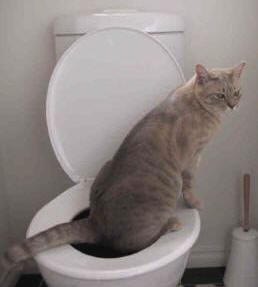Avoid Flush Cat Poop Down Your Toilet - Protect Your Pipes Infrastructure
Avoid Flush Cat Poop Down Your Toilet - Protect Your Pipes Infrastructure
Blog Article
The writer is making several good pointers related to Don’t flush cat feces down the toilet as a whole in this great article following next.
:max_bytes(150000):strip_icc()/0S1A1090-49a8e2c66f8e41d6901f2559787a7f24.jpg)
Intro
As pet cat proprietors, it's important to bear in mind how we take care of our feline good friends' waste. While it may appear convenient to flush pet cat poop down the toilet, this technique can have damaging effects for both the atmosphere and human health and wellness.
Alternatives to Flushing
Fortunately, there are more secure and a lot more responsible means to deal with pet cat poop. Think about the following choices:
1. Scoop and Dispose in Trash
The most typical approach of disposing of pet cat poop is to scoop it right into an eco-friendly bag and throw it in the garbage. Be sure to utilize a specialized clutter inside story and throw away the waste without delay.
2. Use Biodegradable Litter
Go with naturally degradable pet cat litter made from products such as corn or wheat. These litters are eco-friendly and can be safely thrown away in the trash.
3. Hide in the Yard
If you have a lawn, take into consideration burying feline waste in a designated area away from vegetable gardens and water resources. Make certain to dig deep sufficient to avoid contamination of groundwater.
4. Set Up a Pet Waste Disposal System
Buy a pet waste disposal system especially designed for cat waste. These systems utilize enzymes to break down the waste, lowering odor and environmental effect.
Wellness Risks
Along with environmental concerns, purging cat waste can likewise posture health dangers to people. Feline feces might have Toxoplasma gondii, a bloodsucker that can create toxoplasmosis-- a potentially severe disease, especially for expecting ladies and individuals with weakened immune systems.
Environmental Impact
Flushing pet cat poop introduces harmful virus and bloodsuckers into the supply of water, positioning a significant threat to water communities. These contaminants can adversely affect marine life and concession water high quality.
Conclusion
Accountable pet possession extends past supplying food and shelter-- it additionally includes appropriate waste management. By avoiding purging pet cat poop down the toilet and selecting alternate disposal methods, we can reduce our environmental footprint and safeguard human health and wellness.
Why Can’t I Flush Cat Poop?
It Spreads a Parasite
Cats are frequently infected with a parasite called toxoplasma gondii. The parasite causes an infection called toxoplasmosis. It is usually harmless to cats. The parasite only uses cat poop as a host for its eggs. Otherwise, the cat’s immune system usually keeps the infection at low enough levels to maintain its own health. But it does not stop the develop of eggs. These eggs are tiny and surprisingly tough. They may survive for a year before they begin to grow. But that’s the problem.
Our wastewater system is not designed to deal with toxoplasmosis eggs. Instead, most eggs will flush from your toilet into sewers and wastewater management plants. After the sewage is treated for many other harmful things in it, it is typically released into local rivers, lakes, or oceans. Here, the toxoplasmosis eggs can find new hosts, including starfish, crabs, otters, and many other wildlife. For many, this is a significant risk to their health. Toxoplasmosis can also end up infecting water sources that are important for agriculture, which means our deer, pigs, and sheep can get infected too.
Is There Risk to Humans?
There can be a risk to human life from flushing cat poop down the toilet. If you do so, the parasites from your cat’s poop can end up in shellfish, game animals, or livestock. If this meat is then served raw or undercooked, the people who eat it can get sick.
In fact, according to the CDC, 40 million people in the United States are infected with toxoplasma gondii. They get it from exposure to infected seafood, or from some kind of cat poop contamination, like drinking from a stream that is contaminated or touching anything that has come into contact with cat poop. That includes just cleaning a cat litter box.
Most people who get infected with these parasites will not develop any symptoms. However, for pregnant women or for those with compromised immune systems, the parasite can cause severe health problems.
How to Handle Cat Poop
The best way to handle cat poop is actually to clean the box more often. The eggs that the parasite sheds will not become active until one to five days after the cat poops. That means that if you clean daily, you’re much less likely to come into direct contact with infectious eggs.
That said, always dispose of cat poop in the garbage and not down the toilet. Wash your hands before and after you clean the litter box, and bring the bag of poop right outside to your garbage bins.
https://trenchlesssolutionsusa.com/why-cant-i-flush-cat-poop/

Do you really like reading up on Don’t flush cat feces down the toilet? Give a comment directly below. We would be delighted to listen to your responses about this page. Hoping that you come back again later on. Enjoyed reading our piece of writing? Please share it. Let another person locate it. I am grateful for your time. Come back soon.
Call Today Report this page